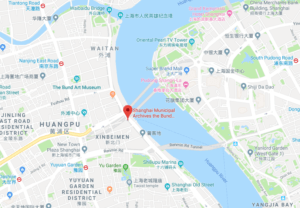First of all, I want to thank Kimmi Cheng (NYU) for her advice and Steven Pieragastini, Ph.D. (Loyola Marymount University) for his review of the Shanghai Municipal Archives, Bund Location from 2013 that helped me get prepared for my current visits and for many of the practicalities. To my experience not that much has changed in the research conditions since Steven’s article, but of course I’ll have to see whether requesting unscanned documents has become more or less difficult. In the past couple of days since I’ve been spending my mornings in the reading room, I was able access scanned material and request documents that are available on microfilm. As for the ‘level 2’, fingers crossed, or as a certain American president likes to say: “We’ll see what happens!”
This is how the registration process looked like for me from preparations to receiving my entry card:
- Obtaining recommendation letters (推荐信) which actually tends to be called a “letter of introduction” (介绍信 )in Chinese. This has to come from a professor of a Chinese institution/university, WITH THE RED STAMP. The letter I brought over from New York unfortunately didn’t have that, but thanks to a helpful friend at the Shanghai Academy of Social Sciences I was able to show the right one at the registration desk. Actually, the staff was really understanding and issued me the card and allowed me to start to work even though I could only submit my stamped letter on the second day.

The Location of the SMA Bund Branch in Shanghai (Google Maps) - Visiting the site at No. 9 Second East Zhongshan Road (中山东二路9号) directly on the southern end of the Bund (外滩). New visiting times are Monday through Saturday 8:30am – 5:30pm. Enter the gate, place your bag on the conveyor belt for security check just like at the subway stations then cross the main hall to the elevator. There’ll be rows of code-locked lockers to leave your belongings, the you can head to the 5th floor. There you’ll find other lockers – this is your last chance to leave your bags/coats/food etc. outside. You can bring in your phone and laptop but your beverages need to stay in this room on the table.
- At the main desk you’ll be asked whether it’s your first time in the SMA, and then you’ll be directed to the registration office on the left. You only need to present your passport (ID if you’re a Chinese citizen) and the recommendation I mentioned above. The latter doesn’t even have to detail the list of documents you wish to see, as other archives might require. And the red stamp. That’s everything. But you probably already know it from other areas of life in China.
- When you receive your “Reader’s Card” (阅档证)you’ll be told to check in at the main desk every time starting from the following day. On the back side of the card, you’ll find your “Reader ID” (阅览证编号), a six digit number which you’ll have to use whenever entering the computer system in the reading room, or submit a request form. Your card and registration will be valid for one month, then you’ll have to repeat the procedure, bringing a freshly dated recommendation letter.
- Now, you’re ready to start at one of the computers.
Requesting and receiving archival records:
- The website of the SMA has an online catalogue, and allows you to do keyword searches. It’s great because you can prepare your list ahead and arrive to the site just putting in those call numbers.
- You enter the computer database using your “Reader ID” and the password is “111”. Then you can search for keywords or by using the structural layout of the archives on the left. Lots of documents are actually scanned, so you don’t even need to stand up from the screens.
- If you want a copy of the files, you can request 50 pages/day to be photocopied. You’ll have to fill out a form called “复制档案申请表” (see the photos of all the forms I’ll mention at the bottom of the post) which then you submit at the main desk. Note, that while you’re submitting the paper form, you still need to choose the pages and request them using the computer! (This way your request can be seen in the system in addition to the feeding the bureaucracy.) You can pick up your copies within 5 days. It seems that the number of pages within a document is also restricted, you can’t request the entire record to be copied, it has to be less than the 2/3 of it. No photos (camera, cellphone etc. is allowed). Bottom line: I highly recommend to transcribe your files and only request photocopy for the most interesting few pages.
- Some of the results will show “微缩” (microfilm) on the right – that means you’ll have to take one of the forms called “微缩档案查阅请表”. After filling out the call number (档号)you need to go and look for the “盘号” (red circle on the photos) and “抽屉号” (yellow circle; it is actually called “位置” in the booklet) in a yellow booklet that lays around the microfilm reader machines. Once you filled out the form you give it to the archivist, who’ll look for the roll for you. You can’t make copies of the microfilms, so you’re left there again with transcribing them.
- In order to request archival documents that aren’t scanned or photocopied, you can guess: yes! you need to fill out yet another type of form. This one is called “查阅档案申请表”. Since I haven’t tried this one yet, I really can’t say more about the process, so stay tuned for the updates!
Feel free to download the photos of the forms, you can even prepare ahead the information you’ll need to fill in!





Leave a Reply
You must be logged in to post a comment.